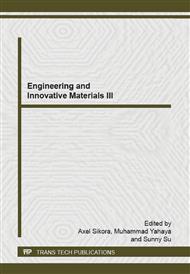p.209
p.214
p.219
p.224
p.229
p.237
p.242
p.247
p.252
The Structural Application of Bio-Composites: A Comparison of Mechanical Properties between Bio-Composites and Glass Reinforced Composites
Abstract:
Green composite or bio-composite refers to a type of composite materials that consists of natural fibres and bio-polymers as its constituents. The green composite has generated great interest in research world and industries due to its advantages of renewability, biodegradability and sustainability. However due to its low mechanical properties, bio-composites has limited structural application, the area that is dominated by glass reinforced composite. As such the aim of the numerous researches on the bio-composite is to prepare green composite to have properties that can replace GRP as structural components. This paper is to compare mechanical properties of bio-composite taken from vast literature and the glass reinforced polymer composite. The properties under consideration include the tensile strength and modulus, flexural strength and modulus, elongation at break and the impact strength. It was found that with careful consideration on the chosen types of fibres and matrix, the treatment given to fibres and matrix and the manufacturing process, bio-composites can be at par or better than the glass mat thermoplastic composite.
Info:
Periodical:
Pages:
229-233
Citation:
Online since:
October 2014
Authors:
Keywords:
Price:
Сopyright:
© 2014 Trans Tech Publications Ltd. All Rights Reserved
Share:
Citation:


